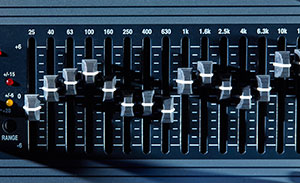Do You Know What EQ Is? The Killer Sound Edit

How many times have you seen the term “EQ” on your car radio or CD player, or your home entertainment system? If you are just learning audio production, no doubt you’ve been bombarded with references to different kinds of EQ (parametric, dynamic, etc.). But has anyone ever just broken it down for you in terms anyone could understand? Let me see if I can do that for you in this article.
Some people just take in information better if it is explained with very few technical terms, regardless of education or intellect. Heck, I have a bachelor of science degree and a masters degree, and I still hate reading overly-technical descriptions. So in that spirit, let’s talk about something that is bafflingly called “equalization,” or “EQ” for short. See, the name itself is not very descriptive, I don’t think. Here is what it really is. Ready for this?
EQ is turning volume up or down. That’s pretty-much it. Too broad? OK, let me add one more thing. EQ is turning volumes up or down on bass and/or treble knobs. I happily use those last two terms because you’ve seen them on your car stereos all your life, so I am making an assumption you’ve played with them and kinda know the difference between bass and treble.
Wasn’t that an informative article? Oh, you need a bit more? Ah, you’d like to know why it’s useful, or at least why you should care. Oh, alright; if you insist. Let’s take probably the easiest example I can think of…your car stereo. The most basic EQ controls are bass and treble. If you’re listening to hip-hop, you may enjoy turning the bass knob (or slider) up because it will make the kick drum and bass synth or guitar much boomier. You can actually feel that bass now. On the other hand, let’s say you just want to listen to a basketball game on the radio. If your bass is turned up, the voice may sound muddy and hard to understand. Turn the bass back down and maybe bump the treble up a little bit. Bingo, you can now hear the voice much better. It will be more clear and easier to understand.
Are you getting the idea? Sometimes people turn both the bass and treble knobs all the way up. Well, this didn’t really accomplish anything except to do exactly what turning the “volume” knob up would have done! Now are you getting it? The difference between the main volume control and the EQ control is that the EQ adjusts ONLY the bass or the treble independently, while the volume turns EVERYTHING (bass and treble) up or down.
Now I sense you can handle a new term…”frequency.” When we say bass, we mean the sounds in the low frequencies of a song. Treble means the higher frequencies. More sophisticated EQs allow you to control more than just the bass and treble, adding a few more frequencies between the two, like “middle” or “low-middle” and “high-middle“. Obviously this gives you more control over what parts of the sound you turn up or down.
There is quite a lot to learn about EQ and frequencies. But for now, take this useful lesson: if you want to impress your friends with what an audio-geek you are, never turn all the EQ knobs or sliders all the way up or down at the same time, or else all you’ve done is turn the master volume up or down. Try turning one up and one down to see how that sounds. Or try moving just one control up or down and leaving the other one alone. That will make you seem much cooler;).
